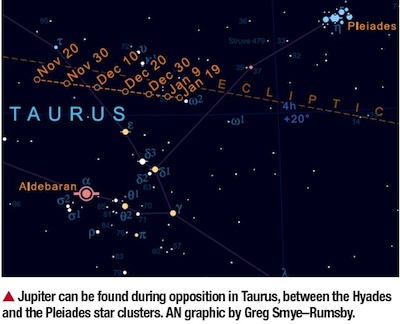
Jupiter at its best
BY MARK ARMSTRONG
ASTRONOMY NOW
Posted: 29 November 2012

Jupiter comes to opposition on 3 December and is well placed for some months to come, giving amateur astronomers a great opportunity to observe and image the Solar System's largest planet and undoubtedly the most rewarding and easiest to observe planet.

Most observers will have already been following and enjoying the gas giant for some time already but it's at its brightest and biggest around opposition and is observable all night. This opposition is particularly favourable with the dual advantage of Jupiter's very generous altitude at culmination and its large apparent diameter through the eyepiece. Jupiter appears so big to us in comparison with say Mars or even Saturn that it's easy to get blase about it. But during its 11.86-year orbit around the Sun its distance from Earth varies; at the 2010 opposition Jupiter was at its closest and its apparent equatorial diameter was 49.9 arcseconds, as big as it can get (its minimum is 43 arcseconds when at aphelion). This time around it will be 48.5 arcseconds, not too shabby and coupled with an elevation of almost 60 degrees around midnight, makes it a great opposition for Northern Hemisphere observers.
On opposition night Jupiter rises at 4pm and is well above the crucial 20-degree elevation mark by the time the skies are astronomically dark shortly after 6pm. Jupiter traces out a huge arc across the sky during the course of the night meaning that it's above 20 degrees altitude in a dark sky for over 11 hours, giving keen and hardy observers enough time to witness one complete rotation of the planet's cloud tops. Jupiter blazes away at magnitude -2.8 and is a magnificent sight against the brilliant backdrop of the bright constellation of Taurus. Jupiter has been moving retrograde (westwards) through Taurus for some time and its current position lying between the great Pleiades and Hyades open cluster makes for a splendid imaging opportunity.

Christopher Go imaged Jupiter on 5 November 2012 from Banilad, Cebu City, Philippines showing the Great Red Spot and Oval BA. Chris used a Celestron 14 and a Point Grey Research Flea 3 camera. Image acquisition was done using Torsten Edelmann's Firecapture 2.1 software and processing was done using AutoStakkert and Registax.
The face that Jupiter presents to us is not a solid surface like Mars or Mercury but the cloud tops of its incredibly dynamic atmosphere with constantly changing features and detail within a familiar structure of long-lasting dark belts and bright zones that generations of astronomers have kept under constant surveillance. Jupiter's disc can be resolved even in binoculars and a 50-mm class 'scope will show the two major equatorial belts and the polar regions. Employing a magnification of 150x will be sufficient to show lots of detail through the eyepiece; high quality refractors in the 125-mm class and above and reflectors and SCT's in the 150mm- 200-mm class will reward the keen Jovian observer with a lifetime of enjoyment. Jupiter's longest lasting feature is the famous Great Red Spot (GRS), a huge oval-shaped, seemingly perpetual anticyclonic storm that has been observed since the 17th century. It varies in size and intensity and currently its most intense brick-red colour, which makes it easy to see in a 50-mm 'scope, is more like salmon-pink now, making it tougher to spot in anything less than a 100-mm. The GRS drifts constantly in longitude through the southern South Equatorial Belt (SEB) and can currently be found at System II longitude of 186 degrees.

Christopher Go imaged Jupiter on 24 November 2012 from Banilad, Cebu City, Philippines. Chris used a Celestron 14 and a Point Grey Research Flea 3 camera. Image acquisition was done using Torsten Edelmann's Firecapture 2.1 software and processing was done using AutoStakkert and Registax.
At the time of writing 'oval Ba' or Red Spot Junior, a smaller but currently a deeper shade of pink than the GRs, has just passed to its south and is at system II longitude of 170 degrees. The region of the SEB following the GRS for around 30 degrees of longitude is a seething mass of complex structure. Other features such as dark barges and white ovals are very common; currently there is a dark barge in the SEB at system II longitude of 113 degrees, a dark oval right next to oval BA and a series of white ovals south of the GRS and oval BA in the South South Temperate Belt.
The four Galilean moons of Jupiter, Io, Europa, Ganymede and Callisto, are another outstanding observation advantage that Jupiter has over the other planets, with their constant dance around their parent being a joy to follow and providing great observing opportunities. Binoculars are sufficient to see all four moons but perhaps a 150-mm is a good size instrument to comfortably observe all the satellite phenomena. Eclipses and reappearances are easy to see, the moon winking in and out of view, as are occultations. The dark shadows of the moons are readily observable in small to moderate 'scopes but the moons themselves can be tougher and generally require larger apertures and good seeing conditions. Transits produce spectacular images. One important thing to note is that due to three degree tilt of Jupiter's equator to the plane of the ecliptic, the outermost moon, Callisto, appears to pass south of Jupiter and will not produce any phenomena events until after conjunction. Watch out for a great event on opposition night 2/3 December around 10pm when Io occults it own shadow.

Jupiter's Galilean moons will begin to catch up with their shadows on the disc of the planet, overtaking them at opposition. This can be most clearly seen in the case of Io during the first week of December. Credit: AN graphic by Greg Smye-Rumsby
|



